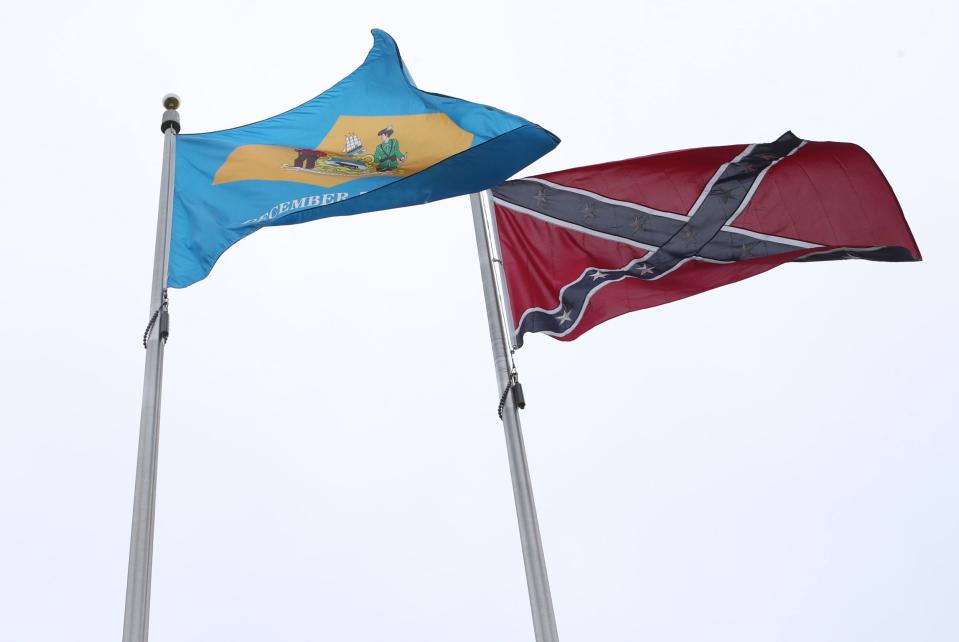Georgetown Historical Society: A missed chance to remove Confederate flag | Opinion
Editor's note: This letter was sent to the Georgetown mayor and town council July 30:
Dear Mayor and Members of the Town Council:
The Southern Delaware Alliance for Racial Justice is disappointed that funding for the Georgetown Historical Society was approved. This letter addresses the next steps the Town has pledged to take concerning the Confederate memorial/flag issue.
Finances are key
Council Member Diaz-Malone got it 100% right when she said it is about money and that the historical society would have a lot more money if the Confederate monument and flag were brought inside into a museum setting with proper curation.
The state has refused to fund the historical society because of the Confederate monument and flag. The governor of Delaware opposes the monument and flag. The historical society gets no rent that we know of for “hosting” the divisive memorial and flag that was provided and apparently owned and maintained by others.
Earlier coverage:Georgetown votes to give Confederate flag-flying museum more than $24K
Financial peril: Can historical society remain a going concern?
Shockingly, 2020 historical society financial filings — for the period ended June 30, 2020, meaning only the initial months of COVID-19's impact on the numbers) report only $62,755 of total revenue, with $62,723 of total functional expenses! Total revenue in 2019, the year the state denied funding, was $98,507 — a 36% decrease in revenue in one year. 2021 and 2022 information must be obtained.
The town gave the historical society $24,000, which, as far as we can determine, was not revealed as a nearly 40% increase in its 2020 budget and expenditures. That indicates severe financial stress.
Can the historical society remain as a going concern unless it can raise significantly more money, unlikely without changes?
Richmond, Virginia is experiencing a renaissance after it placed most of its Confederate memorials into properly curated museum settings. Georgetown and Sussex County should follow that example.
What curation could mean

What might proper curation look like?
First, it would not ignore those Delawareans who fought against their country; it would add context and explanation.
Second, this is a very brief draft of what might be said:
The memorial contains the names of Delawareans who left Delaware for other states to enlist in the Confederate army. Delaware was the only one of the four “slave” states that remained in the United States unable to field a regiment or militia of its citizens to fight against the United States.
The plaque placed next to the memorial/flag in its former outdoor location said as few as 300 Delawareans may have fought for the Confederacy; many sources suggest it may have been about 2,000.
At the time of the Civil War, Delaware had a population of 110,418, which included about 20,000 free African Americans. An additional 1,798 Delawareans were enslaved.
There were 11,236 white soldiers from Delaware who fought for the Union in the Civil War, plus 94 sailors and marines. An additional 954 Black soldiers from the First State have been identified as having fought for their country against the Confederacy, with estimates ranging as high as 1,500. Casualties of killed and wounded were high.
More than 10% of the population of Delaware fought for the United States in the Civil War. Recall that only men fought.
Nearby exhibits provide additional information about the First State’s involvement in the Civil War. At various times during the Civil War 33,000 Confederate prisoners of war were held at the Delaware Prison Camp on Pea Patch Island, known as Fort Delaware. Delaware’s DuPont Company was a key supplier to the United States military. Many Delawareans were active participants in the Underground Railroad. Harriet Tubman, a Delmarva native, became the first woman to lead American troops into battle during the Civil War.
Three Delawareans received the Congressional Medal of Honor, the United States’ highest military honor, for their heroism at the Battle of Gettysburg — three of 63 Medals of Honor awarded for that major battle. The First State more than carried its weight during that terrible war.
The actions of the few Delawareans who fought against the United States can be remembered as well as the actions of the vast majority who fought for their country.
Importantly, for the town, historical society and county, if the Marvel Museum is to survive, it must change. The financial numbers tell the story. The history accumulated and shown at the museum should not be lost.
The Alliance offers to work with the town, historical society and interested parties to move forward to eliminate the divisive symbolism and tell the full story of an era we must not forget. The Alliance has many supporters who are residents of the Town and even more who frequent Georgetown. Let’s work together to cure the error made in 2007 and move the historical society forward.
Tom Irvine chairs the history committee of the Southern Delaware Alliance for Racial Justice.
This article originally appeared on Delaware News Journal: Georgetown Historical Society Confederate flag missed opportunity

